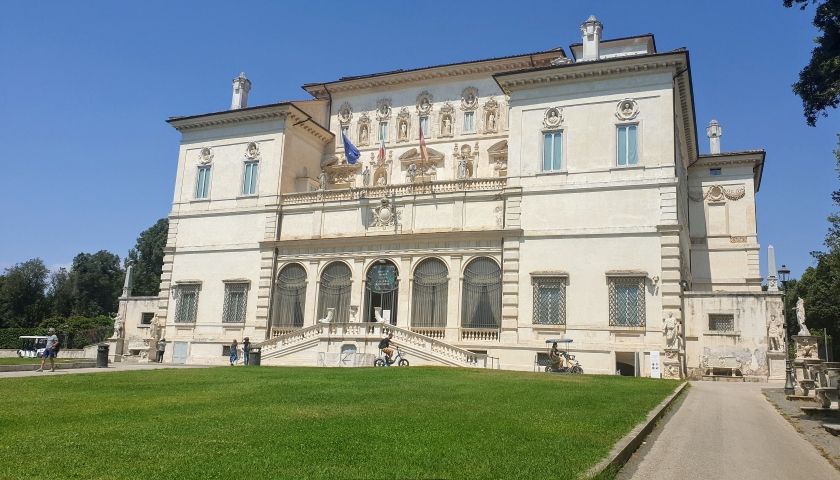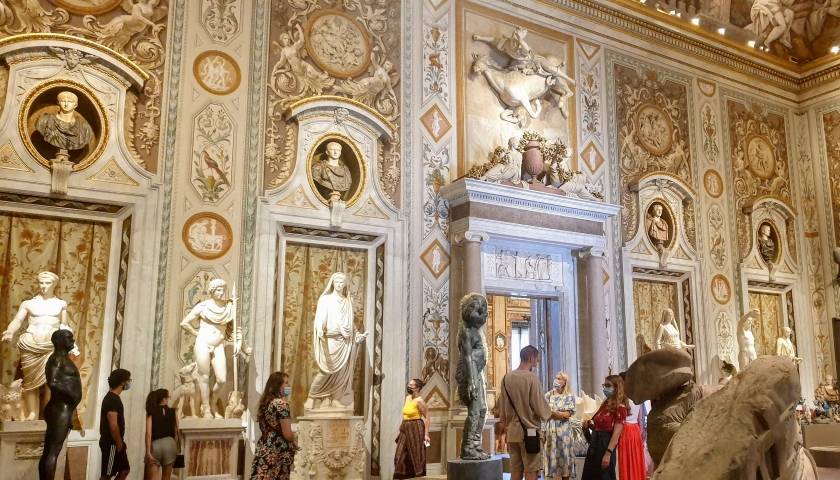Located amidst the greenery of the favorite public park of the Romans, the Borghese Gallery houses one of Rome’s greatest art collections. Known as the ‘Queen of the Private Art Collections’ this outstanding museum boasts paintings and sculptures by major Italian artists that will leave you in awe. A feast for the eyes the Borghese Gallery is one of Rome's must sees.
Visitors flock from all over Italy and the world to contemplate not just the spectacular interiors, but the museum’s masterpieces. The principal works include the notorious (at the time) nearly nude sculpture of Pauline Borghese (Napoleon's sister), Bernini's David, and Daphne and Apollo, Raphael's Deposition and other works by Titian, Bellini, del Sarto, Perugino and Caravaggio.
This superb collection is housed in the villa’s central building, the Casino Borghese. It is spread over 20 rooms on two floors: the ground-floor gallery, which features sculptures, Roman floor mosaics and frescoes, and the upstairs picture gallery. As you step inside the museum, you are immediately thrown into the splendor of the art.
The Borghese Gallery collection of masterpieces
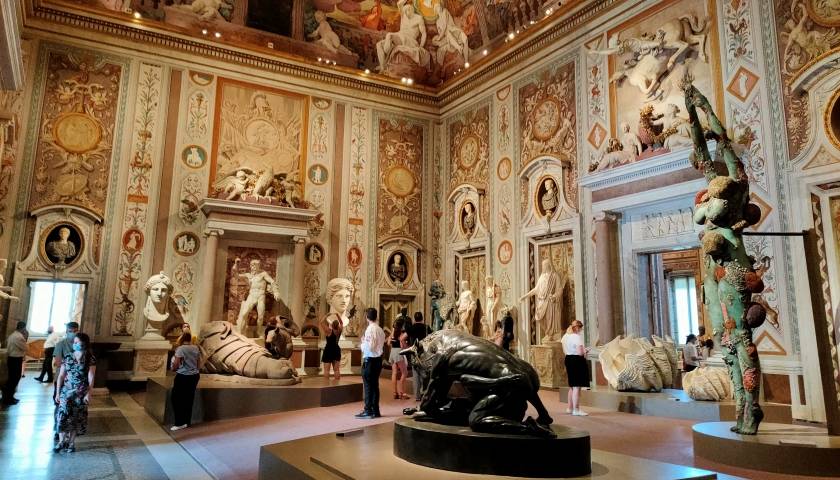
The museum’s collection is an authentic artistic treasure chest, the result of the passion for art of Cardinal Scipione Borghese, who in the early 1600s had the villa built on the suburban property donated to him by his uncle, Pope Paul V, with the specific purpose of housing his art collection.
Cardinal Scipione Borghese built this 'suburban villa' for entertaining, and at the same time amassed one of the world's greatest private collections of sculptures and paintings, much given to the Louvre at the time of Napoleon. The remains are nonetheless one of Rome's finest patrician collections.
Although he was often unscrupulous in his dealings with artists, he had a superb eye and was hugely influential in the careers of many of our favorites, including Gian Lorenzo Bernini, Caravaggio, Titian, Raphael, and Peter Paul Rubens. In building his Gallery and Gardens, he was clearly imitating the emperor Hadrian. In our times, we might liken him to J. Paul Getty.
Stepping inside the Borghese Gallery
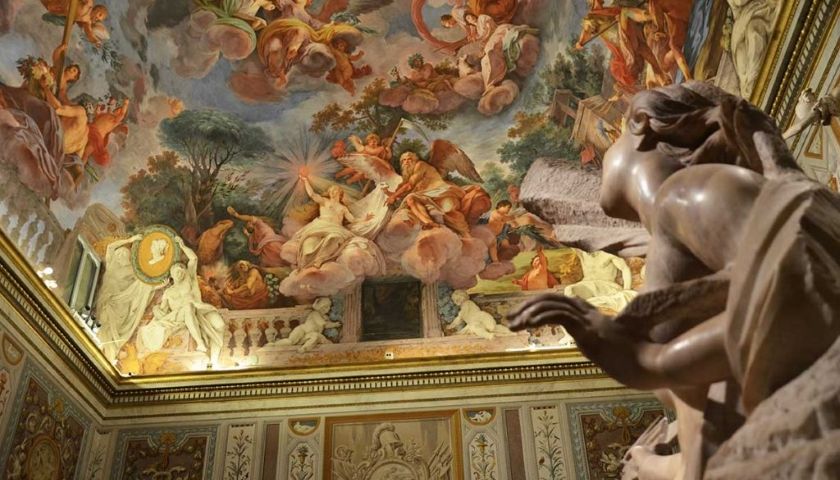
Any art lover who is planning to go to Rome would not dream of missing a visit to this boutique museum. But like many great beauties, the Borghese Gallery knows how to play hard to get. Walk-ins are not accepted and you must reserve your tickets in advance. You can carry nothing in except the glasses on your nose and mobile in your hand.
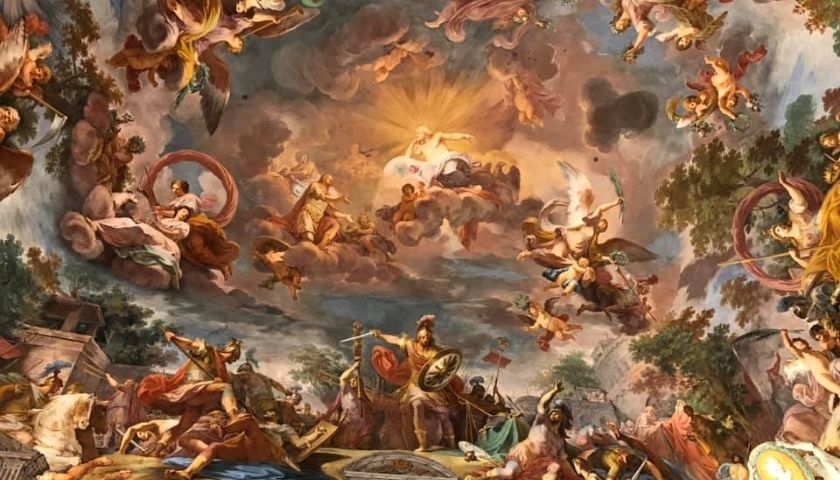
Once you are approved for entry, climb the delightful spiral steps. This is literally your stairway to heaven, for at the top is a vast salon whose ceiling bears a majestic fresco in which Giovanni Lanfranco depicted Jupiter surrounded by the council of the gods. It's the first of many breathtaking frescoes and wall decorations that rival the collection's more illustrious masterpieces.
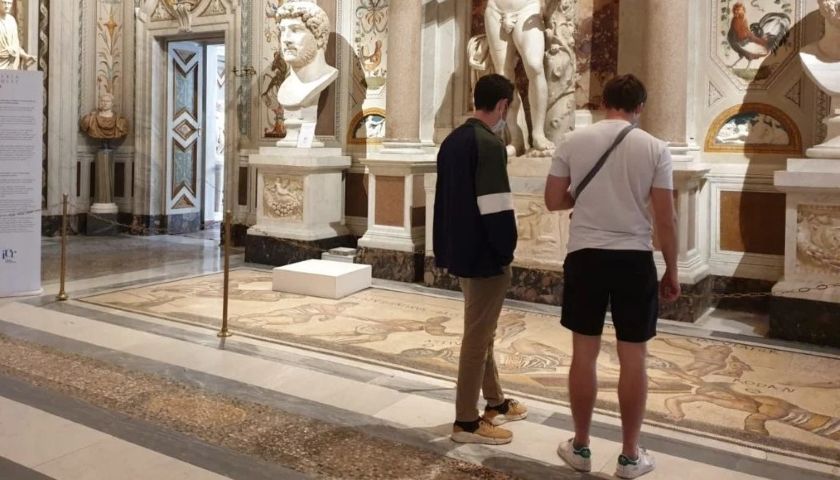
Beneath your feet are several ancient mosaics, most notably the 4th-century depiction of gladiators. All along the walls are classical statues, busts, reliefs, stuccos, cameos, columns, pediments, medallions and other monumental bric-a-bric, and a truly dramatic equestrian statue by Bernini's father, Pietro.
What to see on the ground floor
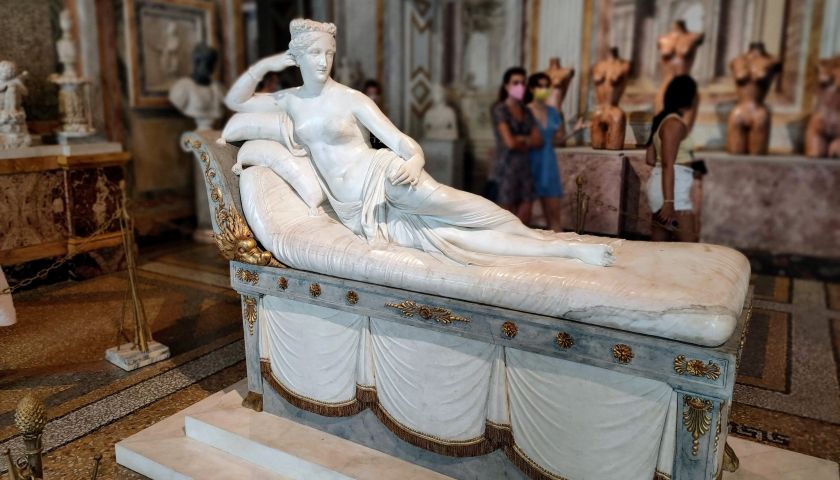
If I were Dante, I would call what follows now "the eight circles of heaven." We start in Room I (Sala I), known as Sala della Paolina, where Antonio Canova's Pauline Bonaparte lounges on her sumptuous marble and wood sofa (which once rotated, by the way). Be careful not to let your love of Pauline distract you from Valadier's Herm, which features an exquisite bronze head atop a golden marble body.
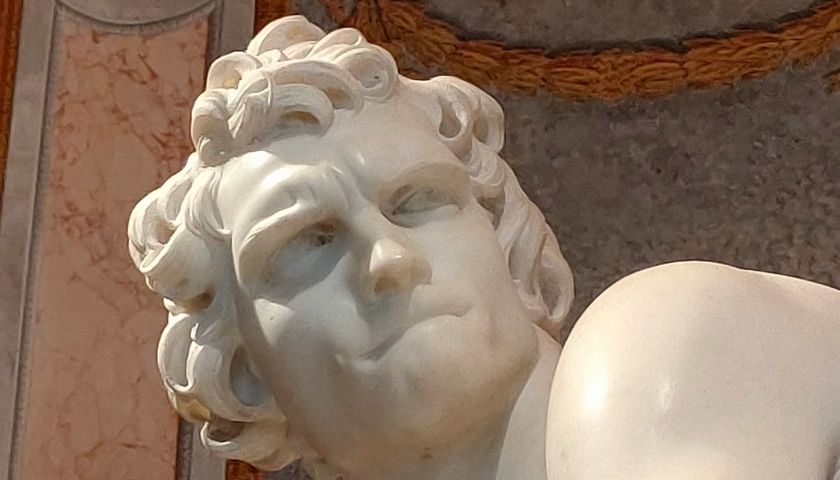
Cardinal Scipione was an early patron of Gian Lorenzo Bernini, and perhaps the show-stealers on this floor are precisely the sculptor’s works. Room II (Sala II) is dominated by Bernini's David, executed at about the same time as the artist's self-portrait as a Young Man (Room XIV/ Sala XIV). The Old Testament hero's eyes bear a very similar expression, yet here it reads as anger and determination.
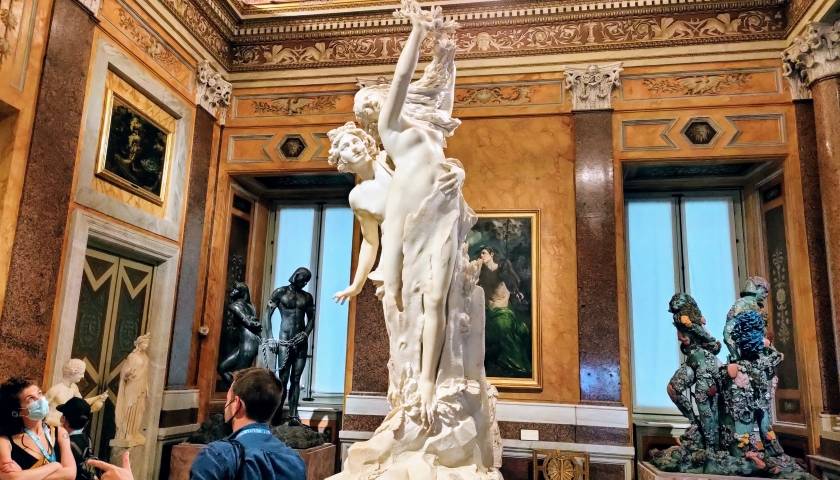
Room III (Sala III) is the metamorphosis chamber. Here are Dosso Dossi's paintings of Circe (or Melissa) changing humans into lemurs, and his Apollo, along with Bernini's delicate Apollo and Daphne. Just look at how the innocent maiden is already turning into a tree to elude the god's lascivious advances! For an idea of Bernini's extraordinary talents consider that this statue was finished the year before David and the year after the Pluto and Proserpina in Room IV (Sala IV). An even earlier work, the Aeneas and Anchises, is in Room VI (Sala VI), near what many consider to be the artist's most personal work, Truth. Almost 40 years separate the two figures.
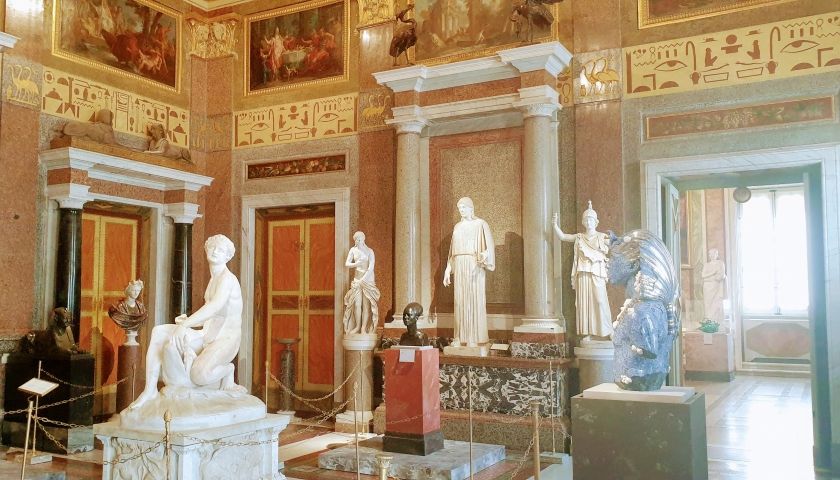
Many masterful classical pieces fill the remaining rooms on this floor. Room VII (Sala VII), was designed in the Egyptian style. It makes a fitting antechamber to "the inner circle of heaven." In this room, we can forgive all the venal sins of the 20th-century masters of the Borghese, for perhaps the most brilliant thing they did when renovating the museum was to gather up six large canvases that had formerly been scattered throughout the building.
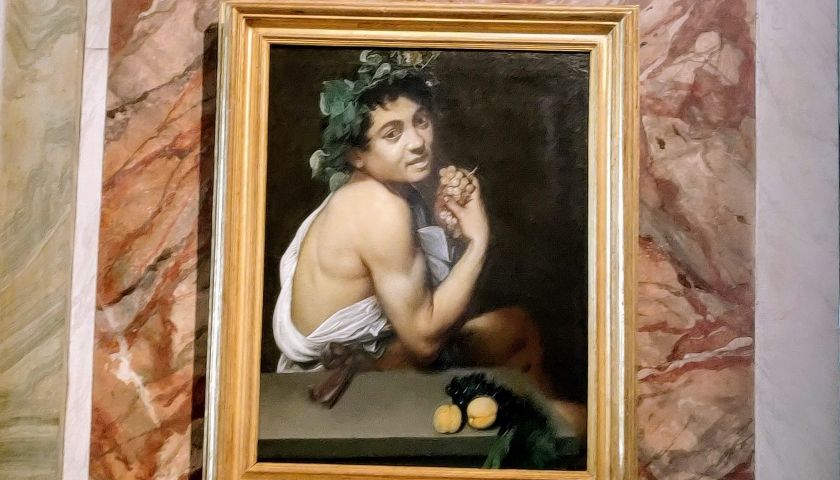
Now, the last room you visit on the ground floor is Room VIII (Sala VIII), devoted almost entirely to another artistic genius: Caravaggio (Scipione was an avid collector of his works). Famous paintings here include Young Sick Bacchus, an early self-portrait. The exquisitely realistic Boy with a Basket of Fruit. David with the Head of Goliath, where Goliath’s severed head is said to be a self-portrait. Madonna with Serpent, where Mary teaches young Jesus how to crush the serpent, symbol of sin and heresy, and St. John the Baptist, probably Caravaggio’s last work.
I will leave it up to you to decide which is your favorite. In my own case, I find it changes each time I visit the gallery. Save plenty of time for this room, because in true Borghese fashion, it also contains several other masterful paintings you might otherwise overlook. Let me just mention a very few of the other unforgettable works that now reside on the Borghese's top floor.
What to see on the top floor
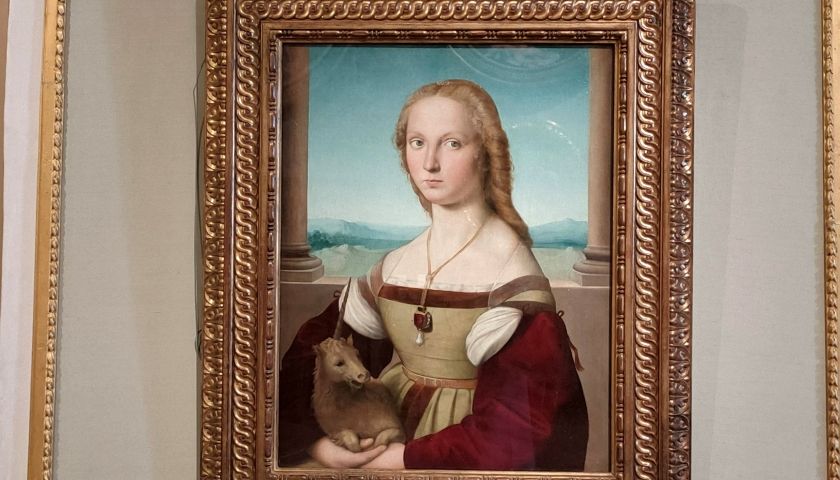
Lovers of Renaissance art will find much to their delight upstairs, as the Pinacoteca features some amazing Renaissance-era paintings (another passion of Scipione Borghese). Highlights here include Raphael‘s early works The Deposition in Room IX (Sala IX) and Lady with Unicorn. Also in Sala IX, known as Sala di Didone, are Fra Bartolomeo’s Adoration of the Christ Child, Perugino’s Madonna and Child and Pinturicchio's Crucifixion.
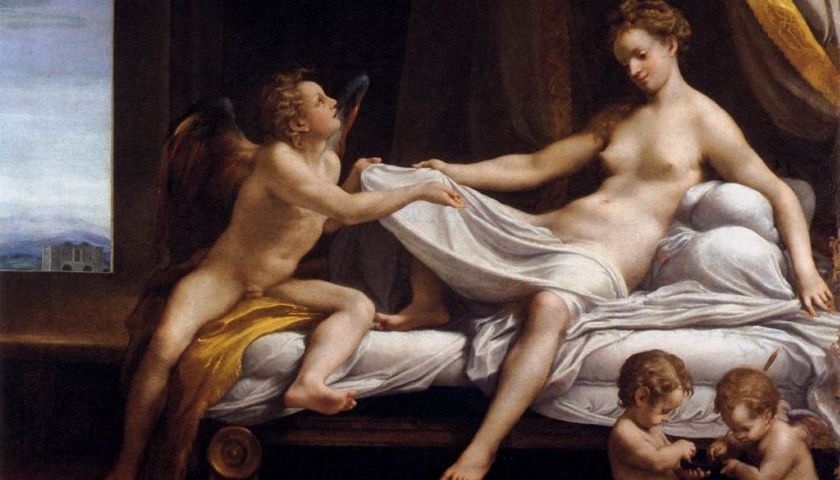
Of course, Bernini's are not the only glorious nudes in the Borghese Gallery. Across the terrace in Room X (Sala X) is Correggio's Danäe, a lady who enraptured all Europe for three centuries. Actually, this room is full of nude women, men and children! My favorites are the cuddly baby Jesus and young St. John in Andrea del Sarto's painting. Next door in Room XII (Sala XII), there is Sodoma's Pietà where Christ looks much older than his virginal mother. Contrast him with the same artist's adorable baby Jesus, in the same room.
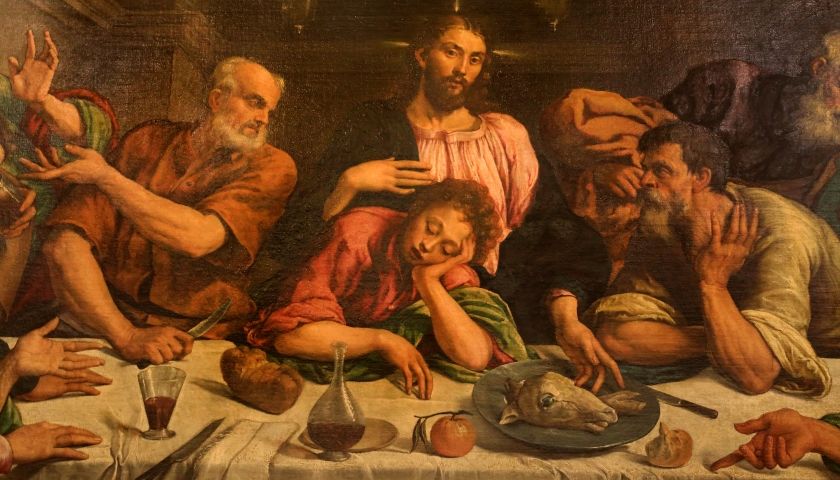
Jacopo Bassano’s Last Supper dominates Room XV (Sala XV). This 16th-century masterpiece contrasts starkly with the Suppers of most artists, who usually depicted the scene in a formal or melancholy way. Here the apostles crowd around the table, a riotous mess of colorful robes, bare feet and muscular working class arms, looking like they're about to start a game of poker. Next door, Room XVI (Sala XVI) I love the swirling crowd of worshippers in Pellegrino Tibaldi's Adoration of the Christ.
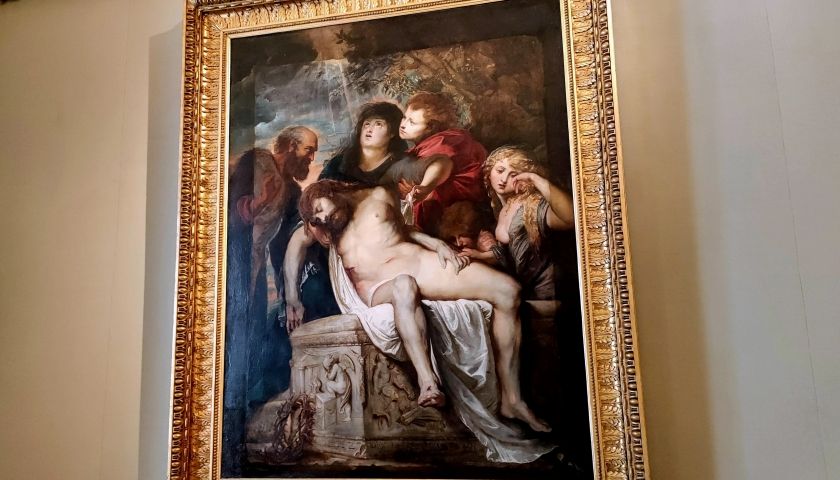
At this point, I quicken my pace toward Room XVIII (Sala XVIII), where I am equally captivated by Rubens' Deposition and Badalocchio's Entombment of Christ. They represent two opposite approaches to chiaroscuro. The figures in the entombment scene are the epitome of human elegance expressing their grief in a channel of emotion and light that flows steadily toward Christ and the tomb. Rubens' figures are much more fluid, almost impressionistic, bathed in a glow that spills down on them from a tear in the clouds, which reflects the gashes in Christ's flesh. His lifeless arms are already turning the same dark inky blue as the tempestuous sky. The canvas completely overwhelms the "small" room.
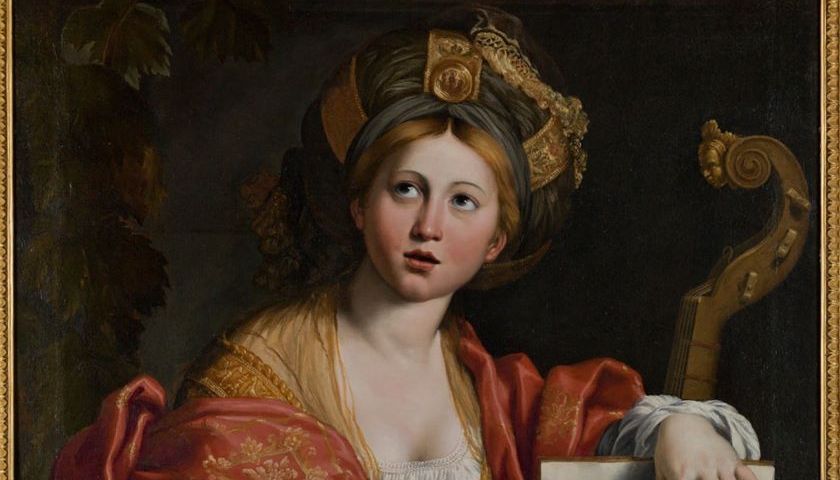
To calm myself down a little, I now pause before Domenichino's gorgeous Sybil, in Room XIX (Sala XIX). Also fascinating in the same room is Federico Barrocci's Aeneas' Flight from Troy. The myth of Aeneas, ancestor of Romulus and Remus, referred to the birth of Rome and thus confirmed the Borghese family's high status in the city.
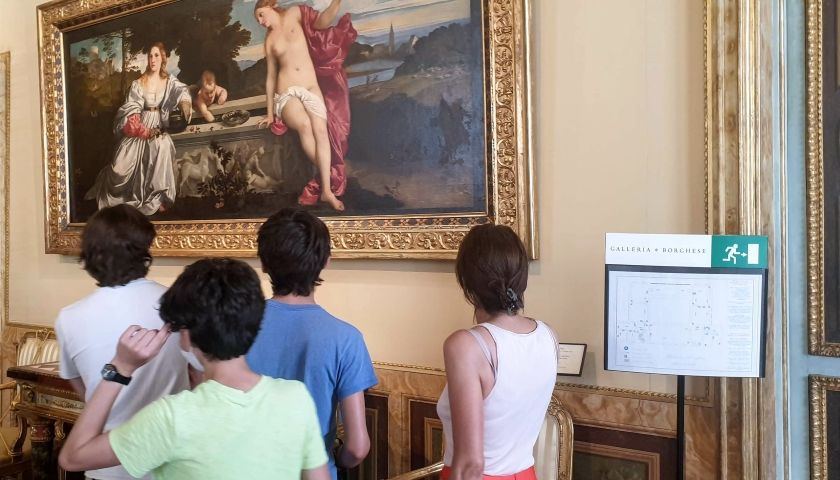
Room XX (Sala 20) is a tough one, because it offers too many wonderful paintings, all of which are overshadowed by Titian's mature Venus Blindfolding Cupid, and his early masterpiece Sacred and Profound Love, painted when he was only 25. This is the work that originally put the Borghese "on the map." In 1899, the Rothschilds offered to buy it at a price that exceeded the estimated value of the whole Borghese Gallery and all the other works in it. Miraculously, the offer was refused.
Borghese Gallery opening hours & visits
Opening hours
The Borghese Gallery is open from Tuesday to Sunday. From 9am to 7pm. Last admission at 5.45pm. Closed on Mondays, December 25th and January 1st.
Borghese Gallery visits
The visit lasts two hours (except for the 5.45pm time slot) and the slots, for a maximum of 180 people each, are at the following times of entry and exit:
· 9am - 11am
· 10am - 12pm
· 11am - 1pm
· 12pm - 2pm
· 1pm - 3pm
· 2pm - 4pm
· 3pm - 5pm
· 4pm - 6pm
· 5pm - 7pm
· 5.45pm - 7pm
How to buy Borghese Gallery tickets
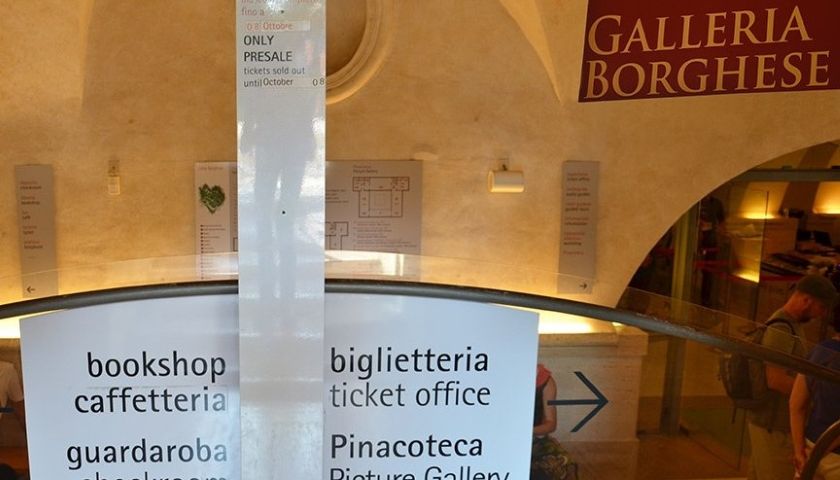
This remains a 'hot ticket' in town. Reservations are mandatory and advance booking is essential as entry is allowed at one-hour intervals and only 180 visitors at a time are permitted. Tickets can easily be bought if there is availability on the Borghese Gallery official website. You can also reserve by phone (+39 06 32810). An English speaker should be available.
Admission cost: 15€ plus 2€ for the reservation (as of November 2021). Entry tickets can vary if exhibition is occurring (usually an additional 5€ ). Once a date and time has been confirmed, the ticket is non-refundable and no changes are permitted. Show up at the museum not later than 30 minutes before your scheduled entrance time to redeem your tickets at the museum desk.
Borghese Gallery guided tours
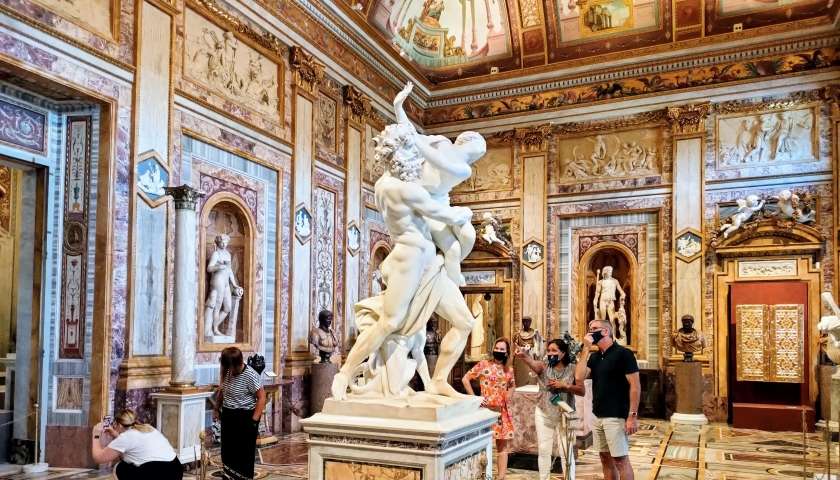
As the collection is vast, a great option is for you to get a private guided tour of the Borghese Gallery that include skip the line tickets with reserved entry time. You make the most of your limited time inside this art museum with a knowledgeable and friendly guide highlighting the collection masterpieces. This popular museum tour often sells out in advance so early booking is essential to avoid disappointment.
How to get to the Borghese Gallery
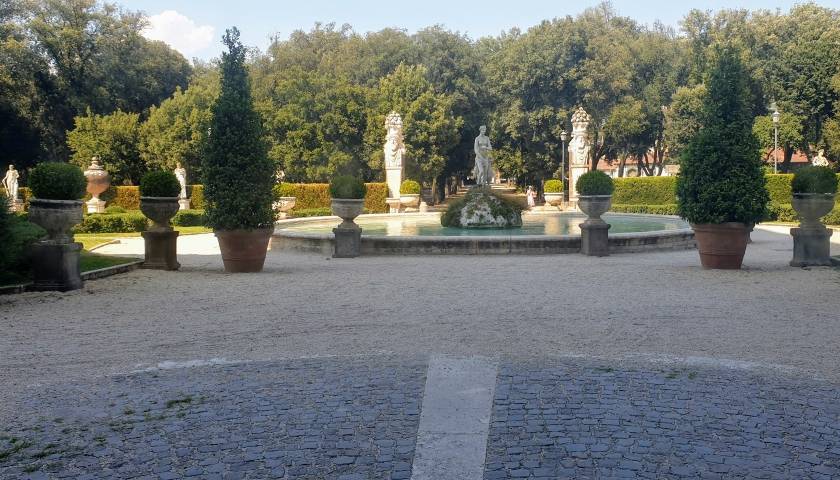
The Galleria Borghese is located at Piazza Scipione Borghese, 5, in the northeast corner of the Borghese Gardens. If you’re planning a visit, you can get here via walking, taxi, or taking public transportation.
Walking: the Borghese Gallery is a 25-minute walk from the Spanish Steps, a 60-minute walk from Vatican City.
By taxi: the Borghese Gallery is a 20-minute taxi ride from the Colosseum.
By metro: you can get off at Piazza di Spagna or Barberini metro station and walk to the Borghese Gallery.
By bus: you can get off at the Pinciana/Museo Borghese stop. From here, the Borghese Gallery is within a 5-minute walking distance.
Helpful hints for visiting the Borghese Gallery in Rome

If you are planning to visit the Borghese Gallery, here are some reminders and tips to help you make the most of your visit to this must-see art museum in Rome.
- The Borghese Gallery is as manageable and relaxing as the Vatican Museums can be sprawling and agitating. One reason is that it only allows 180 people in at a time. Time slots are often sold out in advance so it is very wise to book as soon as you know which day you plan to visit.
- If you want to take a private guided tour, this also need to be booked well in advance.
- Be sure to plan to arrive early. All visitors must be at the museum at least 30 minutes before their scheduled entrance time to collect their tickets. If you have any baggage, you'll need to check it in the locker room and that does take a lot of time depending on how crowded the day generally is. We recommend that you do not bring any large items or bags to the museum if you can avoid it. If you arrive after your scheduled entrance time, you may be denied entry.
- The Borghese Gallery has a strict policy about what you can take inside the museum. The museum does not allow any bags, purses, prams, trolleys or umbrellas into the galleries. All such items must be checked in the cloakroom before entering the Gallery. In addition, it is forbidden to enter the Borghese Gallery with food, beverages (including water), or animals (with the exception of guide dogs). The cloakroom is free to use for museum visitors and is located just outside the museum entrance.
- The Museum is subject to COVID -19 containment measures. As of November 2021, the Borghese Gallery bookshop is temporarily located outside the museum and is open from 8.30am until 6pm. The audio-guide service is suspended and the cafeteria is closed. For updates and guidelines, please check the Borghese Gallery official website.
- We recommend taking time to explore the Villa Borghese Gardens which is like the Central Park of Rome, before or after your visit. While you're in the Villa Borghese area consider visiting the Villa Giulia, the city's fine collection of Etruscan artifacts. Relatively little is known of the civilization which pre-dates the Roman. Much of Rome's traditions and culture appear to stem from the Etruscans. You'll find the museum just outside the northeast corner of the park. It's a rewarding visit.
- If you’re looking to further better your experience, plan your trip to the Borghese Gallery around late afternoon. This will give you the opportunity of enjoying the Borghese Gardens and the Pincio Terrace during sunset for a picture-perfect view over Rome.
- Finally, if you are planning your trip to Rome, we recommend checking out our private tours.
Where to eat near the Borghese Gallery: restaurants & pizzerias
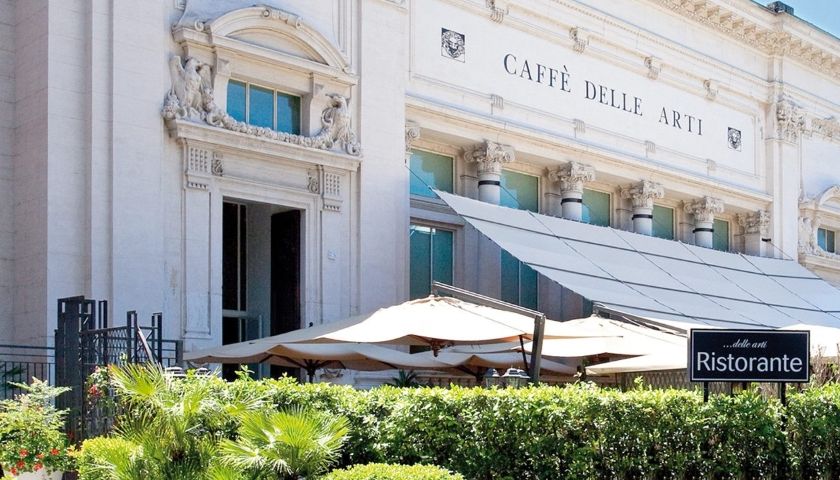
Looking for a great restaurant or place to eat something before and/or after your Borghese Gallery visit? Despite the abundance of touristy spots, there are some excellent places to eat nearby. I've been to and recommend every place on this list, for the convenience, the ambiance, for the food, or all of the above. They are almost all within a 15/20-minute walk from the Borghese Gallery.
Pizzeria San Marco - Pizza & Restaurant
Ai Fienaroli - Pizza & Restaurant
Harry's Bar Rome - American Bar & Restaurant
Caffè delle Arti - Bar & Restaurant
Lin 林家小馆 – Chinese Restaurant
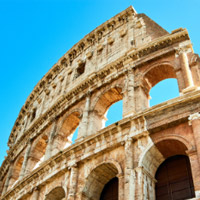 Rome & Vatican
Rome & Vatican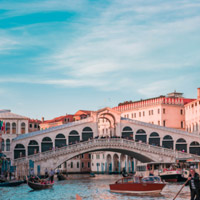 Venice
Venice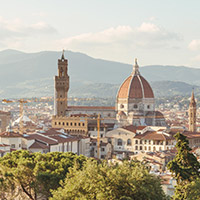 Florence & Tuscany
Florence & Tuscany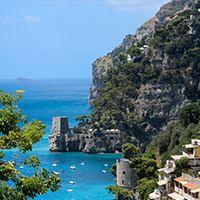 Napoli & Amalfi Coast
Napoli & Amalfi Coast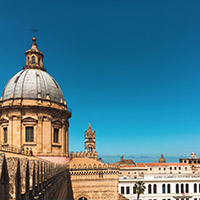 Sicily
Sicily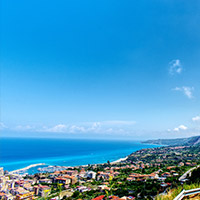 Calabria
Calabria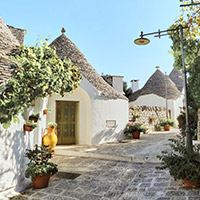 Matera & Puglia
Matera & Puglia